At the last TPAC workshop on the Regional Transportation Plan update, Metro presented their research on roadway conditions (freeways and arterials). There are some very interesting ways to visualize the situation.
[Note: click on any slide to see a larger (and clearer) version.]
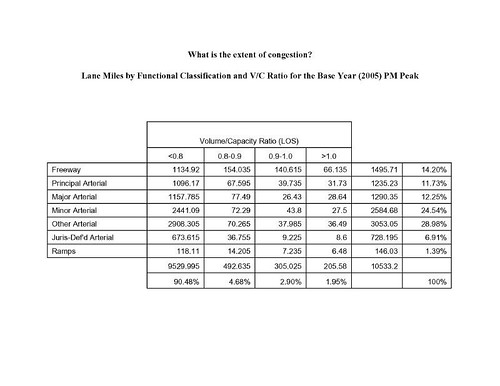

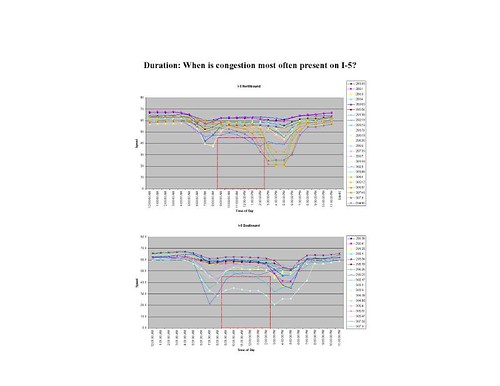
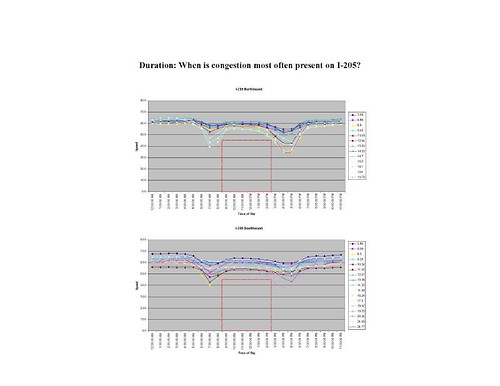
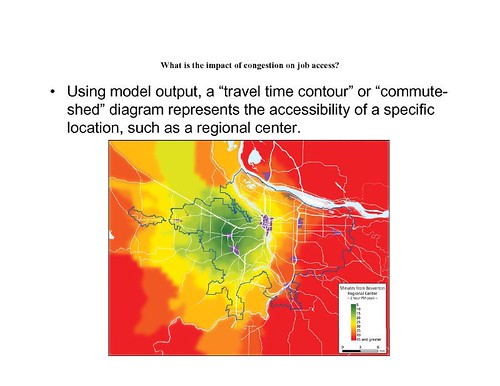


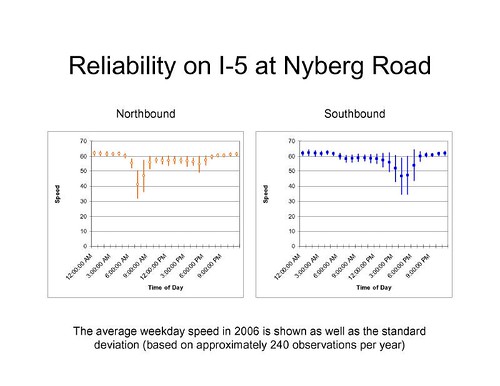
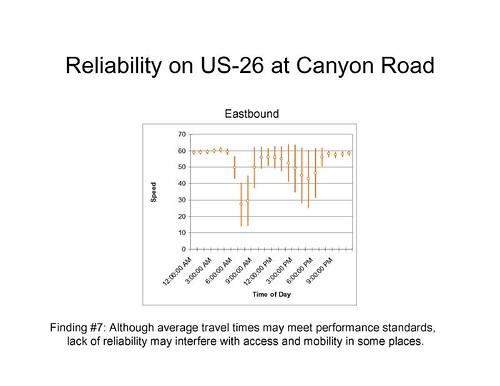
30 responses to “Advanced Topics in Congestion”
“On the other hand I-205 seems to be working pretty well off-peak.”
Too bad the YOU folks killed the Westside bypass when it was a bargain. I would also be working pretty well and taking that much more of a load off of I-5.
“You folks”??? You know who you are.
Ben: Did you look at the slide for Washington Square Mall? Note how it is very accessable from the western half of the urban growth boundary. The Clackamas County industrial district is very accessible from the eastern half of the urban growth boundary… The reason I bring this up, if the Westside bypass had been built, then it would make sense to expand the urban growth boundary westward, right? The people that killed the Westside bypass did it because they don’t want to expand the urban growth boundary in that direction; Washington County has some of the best soil on the planet, and there are better places to build a city than on really good farmland, that is the entire point of the urban growth boundary.
Don’t get me wrong, taking load off of I-5 is a good thing, but that was the wrong solution to the problem.
why not dig up all of the soil and move it (at the environmentalists expense of course)? Seems pretty simple to me.
Matthew,
You don’t know where the Westside by-pass was to go and you don’t know what you are talking about.
It was killed because it was freeway. Just like the Mt. Hood Freewway was to be and should have been built.
Had we built both when prudent and well planned we would have a far better framework of Freeways to build a better region and transit system.
Now, the Westside is developed more than you think the UGB supposedly stopped it, and transportation chaos reigns supreme.
The UGB itself has become as dysfunctional a policy as any. Poorly selected piecemeal expansions are now non-expansions as other obstackles to developement languish for years.
The UGB neither accomodates growth nor is a usefull planning tool. It’s pure, blind obstruction.
Yet, planners, professors and officials cling to ,the theories and fantasies behind it.
The Western Bypass, as proposed, ran essentially from Wilsonville to Hillsboro. It was almost entirely outside the urban growth boundary and went through prime farmland that remains undeveloped. It also wouldn’t have relieved congestion on 217, muchless I205. Ultimately there just isn’t isn’t that much traffic trying to get from Wilsonville to Hillsboro. The traffic along 217 is a combination of shorter trips.
Just like the Mt. Hood Freewway was to be and should have been built.
Why limit it to the Mount Hood Freeway? Why not the freeways through North Portland and the North/South freeways along 20th and 50th? The original plans for Portland called for a freeway grid with highways about three miles apart. That probably would have prevented congestion because no one would want to live in Portland or locate their business in the region.
Ross,
“Essentially”? Hardly.
Your spin is just that. The in-fill devlopment that has occured in and around Westside bypass corridor is undeniable. Much of the remaining farmland in that specific corridor is tied up in post UGB expansion-planners world avaiting sanity.
For you to say 217 would not have been relieved by the WSBP is pure balderdash. Tremendous volumes are attempoting to get from 26 to I-5 south and 217 is the only option. All the many gridlocked surface streets would also have benefitted. But you are intentionally obscuring as much reality as you can in order to fit the threoretical planners agenda. The WSBP was to also continue north with another bridge over the columbia. That too should have been completed long ago.
With the Mt. Hood freeway and WSBY the region would be FAR better off. Instead we have growing chaos whic you apparently are coompletely unaware of.
Then by suggesting “freeways through North Portland and the North/South freeways along 20th and 50th” you play straw man funny games.
Siting “original plans” for a “freeway grid with highways about three miles apart” and that no one or business would locate here is more straw man nonsense.
The fact is there was a huge gap between some “original plan” and the chosen alternative, “doing nothing” in which the Mt. Hood freeway and WSBP was the reasonable and right choice.
Your views on the Westside are most eggregious.
Having lived and worked all over the westside for decades I have witnessed all of the growth and comical approach to transportation. There are NO grids, freeways, highways, connectors and no genuine plans to add any.
The do nothing approach, with much obstruction, is alove and well,,,ushered along by activists such as you, spinning and revising all the way.
No we should not have and don’t need a freeway or highway every where. But that’s a poor and dishonest excuse for having none.
Worsening the situation is the westside commuter rail. Where TriMet itself says there is not the adequate population and you say not enough demand yet it gets funded and built.
There will be zero benefit to accomodating the needs of growth coming from this lousy boondoggle.
Ben –
Tremendous volumes are attempting to get from 26 to I-5 south
No, there aren’t tremendous volumes of traffic that use 217 that would be served by a bypass. There is certainly some volume making trips all the way along the 217 corridor, but most of it doesn’t start or end on the western end of the 26 corridor out near where it would intersect with the bypass in Hillsboro. That was one of the reasons the bypass was abandoned.
The WSBP was to also continue north with another bridge over the columbia.
Not in the iterations that got into the RTP, although there was a lot of speculation that was the next phase. It has the same problems with lack of existing trips. And the same “benefits” which are to provide development opportunities for the land along it. Again, outside the UGB.
But that’s a poor and dishonest excuse for having none.
There obviously are not none. The bypass was a dishonest excuse to blow out the UGB. Once it was evaluated as a transportation investment instead of as a development tool it failed. If the decision was made to push the UGB out to where the bypass was to be located, there might be some case for it.
you say not enough demand
I didn’t say anything of the sort. You don’t seem to understand the basic problem. The traffic volumes along the 217 and 26 corridors are created by a lot of shorter trip segments. Running a freeway diagonally from Wilsonville to Hillsboro doesn’t help someone get from Cedar Mill to Washington Square or from downtown Beaverton to Wilsonville or Hillsboro or from Hillsboro to Cedar Mill and back.
On the other hand, providing a connection for trips between the Max in Beaverton, Washington Square, Tigard, Tualatin and Wilsonville may well be worthwhile. I think its actual success depends more on the willingness to create pedestrian connections to the stations. That is by no means certain.
There are NO grids
Which is a large part of the problem. The desire for cul-de-sac’s has left a street grid that relies on a handful of major arterials. And those arterials are often clogged with traffic trying to get onto the freeways through the middle of the primary commercial areas. Which is a problem freeways create, channeling traffic onto the few streets that provide access.
Ben, why are you so gun ho to sacrifice a neighborhood? The Mt Hood freeway would have destroyed a beautiful, diverse, liviable place. Is your personal commute more important then this neighborhood?
I’m still waiting for Ben to answer my question from the Local Congestion 101 thread where he apparently pasted, verbatim, a paragraph from an article by Adam J. Benjamin, as though they were his own words — unless “Ben” is really Adam J. Benjamin, in which case, of course, that’s fine. But it is curious that he left out a key and mitigating sentence from the beginning of the paragraph he pasted.
– Bob R.
The diagrams are pretty interesting. My only issue is that they really shouldn’t be in JPEG format.
JPEG is what Flickr will host for me :-)
I could PDF the whole thing, but then it doesn’t show up in the body of the post :-(
“The Mt Hood freeway would have destroyed a beautiful, diverse, liviable place.”
Oh please, I lived in SE at the time.
And much of the property was bought.
It’s not a matter of “my personal commute”.
It’s about a regionwide transportation system which moves vehicles of all kinds.
Not just wastefulll willy nilly commuters.
Bob, yeah I used the excerpt, it was timely.
The point is the city killed RCT by denying fare increases.
Ross, you’re all over the place. The WSBP was freeway like 205. Couching it in some scheme to blow open the UGB is nonsence. It should be in place today with the extension over the columbia.
217 is clogged because all of the surface steeets are too, where many people try to cut around to get to 1-5 or 26 or in between. Your focus on trips here trip there is a dance.
The fact is many trucks and people start from all along 217 but want to get to 1-5, 26 or somewhere. It doesn’t matter how many want to go the full length. However many use 205 the full length to avoid downtown Portland. Your model for the rest of the region.
Your trips speak is dancing.
Dance all you want.
The commuter rail is a joke. Will serve criminaly few while costing far too much. It is intended to create an encuse for huge public subsidies to cram more density along it’s entire path without any regard for road capacity or Trans. system function.
You know it.
The dirty rotten secret is a 14 mile Urban Renewal district without public votes.
“The Mt Hood freeway would have destroyed a beautiful, diverse, liviable place.”
Oh please, I lived in SE at the time.
And much of the property was bought.
It’s not a matter of “my personal commute”.
It’s about a regionwide transportation system which moves vehicles of all kinds.
Not just wastefulll willy nilly commuters.
Bob, yeah I used the excerpt, it was timely.
The point is the city killed RCT by denying fare increases.
Ross, you’re all over the place. The WSBP was freeway like 205. Couching it in some scheme to blow open the UGB is nonsence. It should be in place today with the extension over the columbia.
217 is clogged because all of the surface steeets are too, where many people try to cut around to get to 1-5 or 26 or in between. Your focus on trips here trip there is a dance.
The fact is many trucks and people start from all along 217 but want to get to 1-5, 26 or somewhere. It doesn’t matter how many want to go the full length. However many use 205 the full length to avoid downtown Portland. Your model for the rest of the region.
Your trips speak is dancing.
Dance all you want.
The commuter rail is a joke. Will serve criminaly few while costing far too much. It is intended to create an excuse for huge public subsidies to cram more density along it’s entire path without any regard for road capacity or Trans. system function.
You know it.
The dirty rotten secret is a 14 mile Urban Renewal district without public votes.
The WSBP was freeway like 205.
No, it wasn’t like I-205. I-205 went through the middle of an urban area, not outside it.
The fact is many trucks and people start from all along 217 but want to get to 1-5, 26 or somewhere.
I am not sure how you think they were going to use the bypass to get from anywhere “along 217” to 26 or I5.
However many use 205 the full length to avoid downtown Portland.
As I understand it that isn’t really true. Most trucks and other traffic going through Portland stay on I-5. I-205 gets used by people who have destinations along the corridor, not to bypass downtown.
I’ve heard numbers to the effect of 5% of traffic at the I-5/205 interchange in Wilsonville is going to [or north of] the I-5/205 interchange in Washington. (The other 95% are therefore not going that far, and as such, are not going to take a bypass route.)
I’ve also heard numbers to the effect of 75% of the time it is faster to take I-5 than I-205, but 25% of the time I-205 is faster. When those times isn’t dependent on rush hour, (they are both slower at rush hour,) but tends to be caused by things like construction or accidents, (like the majority of congestion.) The ITS lab in PSU thinks that they should put an electronic sign up, just before the interchange, to tell those people which route they should take.
I’m not finding the source offhand.
Ross,
The WSBP would now be between Beaverton and Hillsboro. Outside an urban area?
And right before another, so what.
Orenco Station was mostly farmland. Now it’s lauded as a model for something even though it’s a auto oriented-rat race.
You obviosuly don’t live, work or dive on the westside.
Yes you aren’t sure about anything regarding driving on the westside are you?
Yo might as well be arguing that you’re not sure how they’re going to use 205 to get from anywhere along the eastside or I-5.
You don’t know what is true or relevant, and you don’t drive around here do you?
I-205 gets used by people who want to bypass a clogged I-5 all the time. I-205 is anouther route when crazy rush hour gridlock due to wrecks, lack of alternative routes and other frequent problems clog I-5.
All you are doing is cherry picking trips and numbers to keep touting anti-road obstruction.
Why not advocate removal of I-205 to reduce congestion?
Matthew, Your focus on trips here and there is like looking at trees and not seeing a forest.
Look all you want, the growth in road capacity demands have not been met for years, are being plannned to be met and will not be met eny time soon. So, there is no plan at all for this region’s 95% vehicle transportation system. Only some PSU/planners irrational theroetical pipe dream which fails miserable to serve as any alternative to the real and worsening needs.
Yet, we’ll be repeating the last 20 years as if it is.
Ross,
The WSBP would now be between Beaverton and Hillsboro. Outside an urban area?
And right before another, so what.
Orenco Station was mostly farmland. Now it’s lauded as a model for something even though it’s a auto oriented-rat race.
You obviosuly don’t live, work or dive on the westside.
Yes you aren’t sure about anything regarding driving on the westside are you?
Yo might as well be arguing that you’re not sure how they’re going to use 205 to get from anywhere along the eastside or I-5.
You don’t know what is true or relevant, and you don’t drive around here do you?
I-205 gets used by people who want to bypass a clogged I-5 all the time. I-205 is anouther route when crazy rush hour gridlock due to wrecks, lack of alternative routes and other frequent problems clog I-5.
All you are doing is cherry picking trips and numbers to keep touting anti-road obstruction.
Why not advocate removal of I-205 to reduce congestion?
Matthew, Your focus on trips here and there is like looking at trees and not seeing a forest.
Look all you want, the growth in road capacity demands have not been met for years, are not being plannned to be met and will not be met eny time soon. So, there is no plan at all for this region’s 95% vehicle transportation system. Only some PSU/planners irrational theroetical pipe dream which fails miserable to serve as any alternative to the real and worsening needs.
Yet, we’ll be repeating the last 20 years as if it is.
Yo might as well be arguing that you’re not sure how they’re going to use 205 to get from anywhere along the eastside or I-5.
I-205 connects the airport, Gateway, Lents, Clackamas Town Center, Oregon City, Gladstone … I-205 functions a lot like Highway 217 in Washington County with similar congestion.
The WSBP would now be between Beaverton and Hillsboro.
TV Highway runs between Hillsboro and Beaverton. The bypass was planned to run through the prime farmland west of Beaverton.
Ross,
You are impossible. I know where the heck TV Highway runs. Good grief. Where do you live?
The bypass was planned to run north and south between Beaverton and Hillsboro.
“Prime farmland”??? So what. Much of it isn’t.
and it’s not forest or wetland either.
WSBP would connect far greater than 217,,just as I-205 connects better than what was there.
217 is too close in.
To say I-205 functions a lot like Highway 217 is pure balderdash.
Ben, I think I see your point, tell me if this is what you are trying to say:
If the UGB is removed, as well as most of the other zoning laws in the state, and California and Washington grow very fast, and we widen I-5 to 5 lanes in each direction, and the railroads go bankrupt, and we stop caring if people ride mass transit, (as well as stop paying for it,) and downtown Portland becomes a burned out shell of a city like Detroit, but at the same time Vancouver and Willsonville become happening places, (unlike the suburbs of Detroit,) then the WSBP makes sense.
Do I have that right, or did I miss some of your other assumptions?
To say I-205 functions a lot like Highway 217 is pure balderdash.
How exactly is highway connecting Oregon City, Gladstone, Clackamas Town Center, Lents, Gateway, and the airport different from a highway connecting Beaverton, Washington Square and Tigard? They even each have an east-west freeway connection in the Banfield and Highway 26.
The bypass was planned to run north and south between Beaverton and Hillsboro.
The route of the bypass was never going to touch Beaverton – it was running out beyond Aloha.
“Prime farmland”??? So what.
I think that is the issue. You aren’t really talking about providing transportation for existing trips. If the goal is to blow out the UGB and spur subdivisions and other development on farmland in rural Washington County then the bypass might be a good investment. But, given our current land use laws and plans, the bypass makes no sense at all.
Come on Ross,
What’s with the list?
“highway connecting Oregon City, Gladstone, Clackamas Town Center, Lents, Gateway, airport”
What kind of technique are you playing with?
Are you imaginging you are being informative telling me what 205 runs through? Or is that just filler and away to avoid responding to my points? I live here. I know what 205 connects.
217 is a glorified expressway by comparison. Close in, short, far less of an interstate and far more limited.
And now you are saying “the bypass was never going to touch Beaverton”
So what? It was to be nearby, virtually right along side it.
You don’t know “what the issue is. Everything you say comes through a filter.
I’m talking about providing the needs of growth.
Dance all you want around that.
Throw in “UGB” “subdivisions” “Blow out”.
You don’t even know what or where the current UGB expansion out there involve. It aint prime farm land being farmed.
“existing trips”?
“Growth” Ross “Growth” Growth means more trips just like more skids means build more schools.
Of course if we stopped building school for 20 years we would be needing more for “existing” students. Would we not?
Focus Ross. Growth. We are either accomodating it or not. With transportation we are not.
You dance around that like you haven’t even noticed or don’t care. Which is it?
Or you are so enamoured with theories about “alternatives” that real needs of growth become too blurred.
The bypass would have been as good as investment as 205. “You” killed it when it was bargain.
If it makes less sense now it’s because of those who killed it.
Highway 217 is no “closer in” than I-205. In fact, they are almost identical distances from the river. They both serve to connect regional centers.
So what? It was to be nearby, virtually right along side it.
No it wasn’t and that was one of the problems. To get anyone to use it you needed to invest in a whole new street grid to connect it to people in Beaverton. Which is to say, when they actually looked at how people might get on and off the new freeway, they couldn’t without creating massive congestion on the existing street grids. Which meant they wouldn’t.
So what you ended up with is a “bypass” that didn’t serve current planned land uses, didn’t have adequate connections to the existing transportation system and wouldn’t take significant traffic off of Highway 217.
The bypass had nothing to do with “accommodating” growth, it was the flip side of “people don’t go there any more, its too crowded.” You want empty roads, move to eastern Oregon. There are a lot of them there. We don’t need to build them here.
Ross,
Where did you move to?
The WSBP would not be any more empty that 205 is.
What happened to the chorus, “if we build it it will just fill up”.
People WOULD use it and the connections issue is rediculous. The whole westside has gone through trememdous growth, it’s a rat race and you obvioulsy live far away from the westside.
Connections would have been easily made and the greater grid would have been served by a new freeway.
What kills be is you DO ignore the needs of growth while pretending the status quo is a viable alternative.
In this discussion I was referring to the “growth” in traffic and the incresased capacity demands being ignored.
You can’t focus.
Too many students in the school? Build another school.
Too many vehicles on our roads?
Yet we don’t need any new roads?
Where do you live?
Too many students in the school? Build another school.
Too many vehicles on our roads?
Yet we don’t need any new roads?
Yep. That’s about the size of it.
Finally,,,,
you admit the exceedingly obvious anti-road agenda. You all can stop the play acting now.
The Oregonian will continue to provide cover. :)
Ben is a spitely troll, and yet you continue to feed it. I would suggest stopping this rather negative activity.
The most negative activity around here is our transportation planning. It’s the deliberate proliferation of choke points throughout the region, while pretending to be planing a working system.
Of course disagreeing gets the “troll” label.
Gosh, that hurts.
Ben is a troll, there is no doubt about that. But trolls help people sharpen their arguments. For instance, on the CRC estimates reach $6B thread, as a result of Ben trolling, someone pointed out that Portland has the 40th average commute time, (even though we are the 24th largest city,) compared to a lot of cities that have spent Billions on freeway grids. In fact, among metro areas, the only two that are larger than us, but have shorter commutes are Tampa and Cincinnati, and they aren’t much larger, and the commutes are only shorter by less than a 2 minutes. But most of the cities that have shorter commute times than us are places like Bakersfield, which has 1/4 of the population.
I wouldn’t know this info if people like Ben didn’t stand around and make people bring it up.
Bring it up, but don’t stop there with your assumptions.
When you assume,,,,,
Those locales who keep pace with growing traffic capacity demands would be totally dysfuntional had they taken our approach.
But by the logic on this blog their congestion problems are direct result of building freeway and raod capacity to accomodate growth.
When you assume,,,